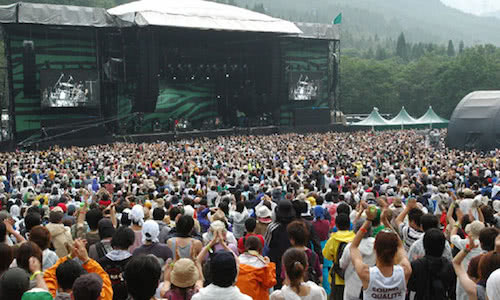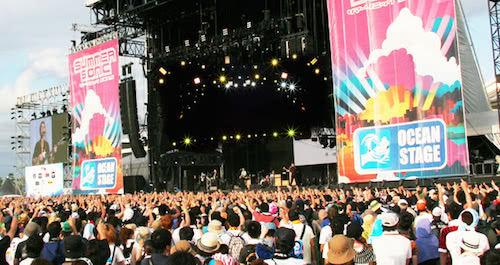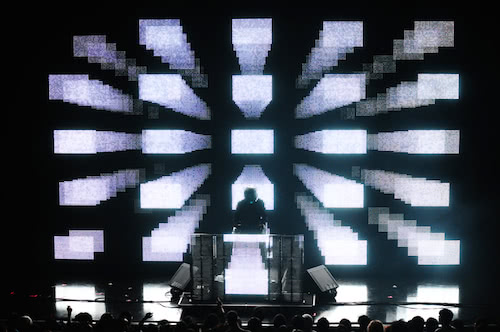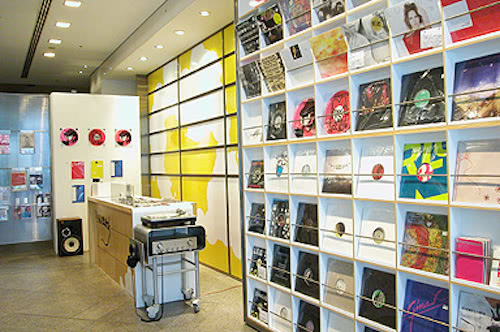From the outright bizarre, to the sometimes innovative, and right through to the insanely popular, the Tokyo music scene has everything you didn’t know existed or perhaps even thought about.
As the world’s largest city with 33 million people it’s not hard to see how Tokyo has a music culture almost impossible to comprehend, let alone fully experience, given its sheer size, diversity, and obscurities.
Tokyo music is either incredibly mainstream or incredibly underground. While the mainstream side of things is as straightforward as you would expect from pop music, the contemporary music of Japan’s capital is complex and immense.
J-pop is the internationally recognised genre that infects much of Tokyo’s population. The domestic popularity of mainstream American acts like Katy Perry and Lady Gaga pales in comparison to the hysteria created by J-pop acts.
Look no further than AKB48, named after the Akihabara district they originate from, who generated a staggering $200 million in record sales alone last year. The 64 member outfit not only have their own store, based in the electronics district, but play shows all year round and are easily the country’s biggest music sensation.
AKB48 have proven so popular that similar ‘franchises’ have been established across the country, including Namba, Osaka’s NMB48 and Sunshine Sakae, Nagoya’s SKE48 – to name a few.
But fans of J-pop aren’t emblematic of the music habits of all of Tokyo’s residents. While music for such people is more entertainment than art, there is a passionate alternative music scene that is thriving undercover.
Japanese venues are called ‘live houses’ and in such establishments you’ll find musicians and fans who are extremely dedicated to supporting the scene.
Inside these live houses hundreds to thousands of bands play around the city each night. From the outside, the venue might look like a regular apartment block, but once you venture inside you’ll find multiple floors of different clubs. One reggae, the other dance, and the top floor might even be dedicated to metal, an entire smorgasbord of genres, all accessed from one lift.
Some live houses though are strictly for one style of music only. In certain districts you’ll discover the hardcore scene, where a house and shop dedicated to particular styles of music are located right around the corner from each other.
The Japanese sense of technological innovation and exploration also seeps into their music. While it is common to find many artists using visual backgrounds at their live shows, there is also a wealth of acts playing game music that sounds like it’s come straight from an old Nintendo game, dubbed ‘8-bit’ or ‘chiptune’ music.
Their love of synthesiser-based compositions is also important to note, first becoming a notable genre in Japan almost before anywhere else in the world in the late 1970s.
Fathers of the movement are Tokyo legends Yellow Magic Orchestra (YMO) who pioneered synthpop through their nine studio albums.
If you dig even deeper into the Tokyo music scene, things can go from experimental to downright strange. Artists performing in disturbing costumes, music being played from an oil drum, and even the use of an axe grinder as an instrument, is not unheard of.
DJs and dance music is also common in Tokyo. Head no further than the districts of Roppongi, Shibuya, Shinjuku, and the affluent, upmarket Ginza for a big night out on the town.
Independent music in Tokyo is easy to admire. Musicians play with the full knowledge that they’ll barely make any money and fans pay up big to see unknown bands just for the enjoyment of live music and their desire to support the scene.
It’s such a contrast from the consumerism that most experience through J-pop, where acts and recording companies make millions of dollars through blatant marketing and sales.
But it’s what makes Tokyo’s underground scene worth exploring. These people are playing music because it’s their craft and not because they have ambitions of making money or winning awards.
While bands from Tokyo achieving international success is largely uncommon, there were eight bands from the city playing SXSW in Austin in 2013.
Head Along To Japan’s Biggest Indie Music Festival In Fuji Rock

While the first festival in 1997 was held at the base of Mount Fuji, from where the event takes its name, since 1999 the festival has been held at Naeba Ski Resort. On the first day of the inaugural event the festival was hit by a typhoon, but despite the extreme weather conditions headliners Red Hot Chili Peppers played through the storm, with Anthony Kiedis even performing with a broken arm. With over 100,000 attendees annually the festival is easily one of Japan’s biggest outdoor music events. Held in late July, the 2012 three-day event was headlined by the likes of Radiohead, Jack White, and The Stone Roses.
Hear Live Music In A Helly Kitty Adorned Shed At Muryoku Muzenji

3-67-1 Koenji-Minami, Suginami-ku
This is unlike any other venue you’ve set foot in before. The tiny gig space somehow fits into a small first floor room under railway tracks. If anything it’s like you’ve just entered into a cat lover’s bedroom, that just happens to be in a shed. The tin walls are decorated with a number of obscurities, from flags to Hello Kitty posters. You’ll hear any number of alternative music styles here, ranging from underground folk to anything lo-fi. If you thought Muryoku Muzenji couldn’t get anymore strange, then think again. Between sets you’re likely to hear Jingle Cats, a collection of meowing Christmal carols, playing on the in-house PA.
Peruse Through Thousands Of Titles At Disk Union

3-31-4 Shinjuku Shinjuku-ku
As one of Tokyo’s best record store franchises, you can find thousands of items in six storeys worth of releases. Specialising in second hand CDs and vinyl, each storey focuses on different genres. Level two and three focus specifically on jazz and progressive rock respectively, while level six is home to books, used products, and audio equipment. Inside the tall and narrow building the stairwell features posters of old glam and punk bands as you move between the cramped floors that are a collectors’ dream.
Experience The Country’s Biggest Mainstream Music Festival In Summer Sonic

As Fuji Rock’s main rival, this festival is held simultaneously in Osaka and Tokyo over two days in August. Around 200,000 people attend the events which host some of the world’s biggest mainstream pop acts, as well alternative artists. The diverse 2012 lineup featured Rihanna and Ke$ha sharing stages with Green Day, Franz Ferdinand, Sigur Ros, and Grimes, just to name a few. Held annually since 2000, the festival has quickly taken the title of Japan’s biggest music festival.
Catch Local Acts at Shibuya O-Nest

6F O-West Building, 2-3 Maruyama-cho, Shibuya-ku
Just one venue in a series of Shibuya O live music houses, it is located in the same building as Shibuya O-West and across from Shibuya O-East. Located on the fifth and sixth floor, O-Nest has live music every night of the week and hosts some of the city’s best indie acts and lesser-known groups. The 200 capacity band room does little for the eye, but the venue gets its reputation from providing an eclectic range of live shows for punters to witness. There is also a bar upstairs, in the unlikely event that you want to get away from the music.
Shop Up At Tower Records, Japan’s Biggest Music Retailer

1-22-14 Jinnan, Shibuya
While this is an international chain, tourists should visit Tower Records in Shibuya as it is Japan’s biggest retail music store and a sky scraper in it’s own right. When we say big, we mean gigantic. The store occupies a selling space of 5,000 square metres and this was before the building’s revamp in 2011. Tower Records sells a range of stock from vinyl to CDs, DVDs and books. If anything, go for the novelty of visiting one of the largest music stores you’re probably ever going to experience.
Witness The Japanese Version Of Barcelona’s SonarSound

The Japanese version of the Barcelona festival has been running for five years now and went ahead in 2011, despite the devastation caused by the earthquake that made international headlines. The event fancies itself as the “international festival of advanced music” and is held in late April with an all night event on the Saturday and a daytime event on the Sunday. Regularly featuring a range of international acts alongside important Japanese artists. Acts such as Flying Lotus, Battles, The Cinematic Orchestra, and Vincent Gallo have performed at the festival in years past.
Check Out Up And Coming Acts At Fever

1-1-14 Hanegi, Setagaya-ku
Newly opened in 2009, this venue has quickly become an important cornerstone of Tokyo’s live music scene for left-of-centre acts, international bands, and alternative Japanese artists. The 300 capacity venue is one of the city’s best small playing areas for up and coming bands. The venue is known for its basic but stylish design as well as having great sound and no obstructed views for punters.
Purchase Electronic Music At Spiral Records

5-6-23 Minami-Aoyama Minato-ku
You’ll find this store just inside the entrance of the iconic Spiral building, which is famous for it’s seemingly floating spiral ramp inside the sky scraper. The modern looking store is also a label for experimental acts, and houses a range of house, techno, punk, funk and electronic music. The store’s listening stations also allow customers to sample avant-garde tunes.
Experience Tokyo’s Hardcore Scene At Heaven’s Door

Keio Hallo Bldg B1F, 1-33-19 Sangenjaya, Setagaya-ku
For many of the heavier indie bands in Tokyo, playing at this venue is like a form of initiation into the local music scene. While this establishment features lesser-known acts, many regulars have taken their turn on the stage over the years. Heaven’s Door operates somewhat like a close-knit family. The grungy, hand decorated basement only allows acts they’ve personally hand-picked to. Some regular events feature niche bands, such as all-girl hardcore and punk outfits, which just goes to show how supportive Heaven’s Door is of Tokyo’s emerging bands.




































